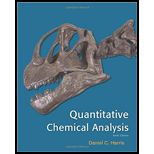
Concept explainers
(a)
Interpretation:
Formula mass of acetic acid and sodium carbonate has to be calculated.
Concept Introduction:
Formula mass of a compound is equivalent to sum of
(a)
Answer to Problem 1.38P
Formula mass of acetic acid is calculated to be
Formula mass of sodium bicarbonate is calculated to be
Explanation of Solution
Formula mass of acetic acid,
In acetic acid
In sodium bicarbonate
(b)
Interpretation:
Amount of acetic acid to be reacted with
(b)
Answer to Problem 1.38P
Amount of acetic acid to be reacted with
Explanation of Solution
The complete and balanced reaction between acetic acid and sodium bicarbonate is,
From the above equation we could observe one mole equivalent of bicarbonate react with one mole equivalent of acetic acid. Hence
(c)
Interpretation:
Number of grams of
Concept Introduction:
Weight percent is one of parameters used to express concentration of a solution. It is expressed as,
(c)
Answer to Problem 1.38P
Number of grams of
Volume of
Explanation of Solution
Thus
Converting grams to milliliters,
(d)
Interpretation:
The limiting reagent has to be identified when
Concept Introduction:
In a
(d)
Answer to Problem 1.38P
Vinegar is the limiting reagent when
Explanation of Solution
In previous steps we calculated
(e)
Interpretation:
Quantity of
Concept Introduction:
Where,
(e)
Answer to Problem 1.38P
Quantity of
The pressure generated to pop the cork out of the bottle is calculated as
Explanation of Solution
One mole equivalent of
Given data:
Volume of
The bottle has
Want to see more full solutions like this?
Chapter 1 Solutions
Quantitative Chemical Analysis 9e & Sapling E-Book and Homework for Quantitative Chemical Analysis (Six Month Access) 9e
 ChemistryChemistryISBN:9781305957404Author:Steven S. Zumdahl, Susan A. Zumdahl, Donald J. DeCostePublisher:Cengage Learning
ChemistryChemistryISBN:9781305957404Author:Steven S. Zumdahl, Susan A. Zumdahl, Donald J. DeCostePublisher:Cengage Learning ChemistryChemistryISBN:9781259911156Author:Raymond Chang Dr., Jason Overby ProfessorPublisher:McGraw-Hill Education
ChemistryChemistryISBN:9781259911156Author:Raymond Chang Dr., Jason Overby ProfessorPublisher:McGraw-Hill Education Principles of Instrumental AnalysisChemistryISBN:9781305577213Author:Douglas A. Skoog, F. James Holler, Stanley R. CrouchPublisher:Cengage Learning
Principles of Instrumental AnalysisChemistryISBN:9781305577213Author:Douglas A. Skoog, F. James Holler, Stanley R. CrouchPublisher:Cengage Learning Organic ChemistryChemistryISBN:9780078021558Author:Janice Gorzynski Smith Dr.Publisher:McGraw-Hill Education
Organic ChemistryChemistryISBN:9780078021558Author:Janice Gorzynski Smith Dr.Publisher:McGraw-Hill Education Chemistry: Principles and ReactionsChemistryISBN:9781305079373Author:William L. Masterton, Cecile N. HurleyPublisher:Cengage Learning
Chemistry: Principles and ReactionsChemistryISBN:9781305079373Author:William L. Masterton, Cecile N. HurleyPublisher:Cengage Learning Elementary Principles of Chemical Processes, Bind...ChemistryISBN:9781118431221Author:Richard M. Felder, Ronald W. Rousseau, Lisa G. BullardPublisher:WILEY
Elementary Principles of Chemical Processes, Bind...ChemistryISBN:9781118431221Author:Richard M. Felder, Ronald W. Rousseau, Lisa G. BullardPublisher:WILEY





